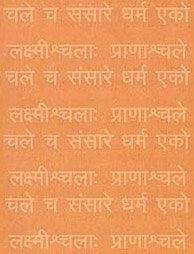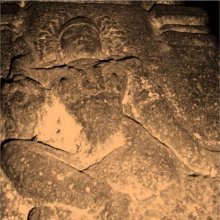Aneka: 21 definitions
Introduction:
Aneka means something in Buddhism, Pali, Hinduism, Sanskrit, Jainism, Prakrit, Marathi, Hindi. If you want to know the exact meaning, history, etymology or English translation of this term then check out the descriptions on this page. Add your comment or reference to a book if you want to contribute to this summary article.
Alternative spellings of this word include Anek.
Images (photo gallery)
In Hinduism
Purana and Itihasa (epic history)
Source: Cologne Digital Sanskrit Dictionaries: The Purana IndexAneka (अनेक).—A son of Raucya Manu.*
- * Brahmāṇḍa-purāṇa IV. 1. 104.

The Purana (पुराण, purāṇas) refers to Sanskrit literature preserving ancient India’s vast cultural history, including historical legends, religious ceremonies, various arts and sciences. The eighteen mahapuranas total over 400,000 shlokas (metrical couplets) and date to at least several centuries BCE.
Samkhya (school of philosophy)
Source: Shodhganga: Prakrti and purusa in Samkhyakarika an analytical reviewAneka (अनेक, “many”).—Aneka here means that which have many variations. Yuktidīpikā means by aneka different (“anekam bhinnam”). By ‘aneka’ Gauḍapāda, Vācaspati and Māṭhara means twenty-three evolutes of mūlaprakṛti, such as mahat etc., whereas ‘sarga’ is indicated by Vijñānabhikṣu by the term aneka.

Samkhya (सांख्य, Sāṃkhya) is a dualistic school of Hindu philosophy (astika) and is closeley related to the Yoga school. Samkhya philosophy accepts three pramanas (‘proofs’) only as valid means of gaining knowledge. Another important concept is their theory of evolution, revolving around prakriti (matter) and purusha (consciousness).
Jyotisha (astronomy and astrology)
Source: Wisdom Library: Brihat Samhita by VarahamihiraAneka (अनेक) refers to “various”, according to the Bṛhatsaṃhitā (chapter 8), an encyclopedic Sanskrit work written by Varāhamihira mainly focusing on the science of ancient Indian astronomy astronomy (Jyotiṣa).—Accordingly, “The five years of the eleventh yuga are—1. Piṅgala, 2. Kālayukta, 3. Siddhārtha, 4. Raudra, 5. Durmati. In the first year there will be much rain and fear from thieves and mankind will suffer from consumption of the lungs and the like asthmatic complaints. In the year Kālayukta mankind will suffer from various evils [i.e., aneka-doṣa]; but in Siddhārtha they will be happy in more ways than one. In the year Raudra mankind will suffer much and there will be loss and ruin in the land. In Durmati there will be moderate rain”.

Jyotisha (ज्योतिष, jyotiṣa or jyotish) refers to ‘astronomy’ or “Vedic astrology” and represents the fifth of the six Vedangas (additional sciences to be studied along with the Vedas). Jyotisha concerns itself with the study and prediction of the movements of celestial bodies, in order to calculate the auspicious time for rituals and ceremonies.
Shaivism (Shaiva philosophy)
Source: SOAS University of London: Protective Rites in the Netra TantraAneka (अनेक) refers to “many (faces)”, according to the Netratantra of Kṣemarāja: a Śaiva text from the 9th century in which Śiva (Bhairava) teaches Pārvatī topics such as metaphysics, cosmology, and soteriology.—Accordingly, [verse 13.1-9, while describing the appearance and worship of Viṣṇu]—“Or, [the Mantrin] worships a very handsome, eight-armed, yellow Deva. [...] He remembers [Viṣṇu’s] many forms. Thus, he thinks [of him] with a collection of many faces (aneka-vaktra-saṃghāta), many weapons and [many] arms [i.e., the cosmic Viṣṇu], reclining, taking a wife, joined with Lakṣmī, alone, [as] Narasiṃha, Varāha, or Vāmana, Kapila, or an honorable man, unadorned, or even without parts. [...]”.

Shaiva (शैव, śaiva) or Shaivism (śaivism) represents a tradition of Hinduism worshiping Shiva as the supreme being. Closely related to Shaktism, Shaiva literature includes a range of scriptures, including Tantras, while the root of this tradition may be traced back to the ancient Vedas.
In Buddhism
Mahayana (major branch of Buddhism)
Source: Wisdom Library: Maha Prajnaparamita SastraAneka (अनेक) refers to “more than one” (i.e., ‘(in) many (ways)’), according to Mahāprajñāpāramitāśāstra (chapter 41).—Accordingly, “[The eighteen āveṇika-dharmas (‘special attributes’)]—[...] (4). The Buddha has no notion of variety.—[...] Furthermore, ‘three times during the night and three times during the day, the Buddha considers beings with his Buddha eye’ and never allows the time of asking himself who can be converted to pass by. Considering beings impartially, he has no notion of variety. Furthermore, the Buddha has praised the good dharmas in many ways (aneka-paryāya). and criticized the bad dharmas in many ways However, faced with good or with bad, his mind shows no increase or decrease: it is only in order to save beings that he makes distinctions. Thus he has no notion of variety. [...]”.

Mahayana (महायान, mahāyāna) is a major branch of Buddhism focusing on the path of a Bodhisattva (spiritual aspirants/ enlightened beings). Extant literature is vast and primarely composed in the Sanskrit language. There are many sūtras of which some of the earliest are the various Prajñāpāramitā sūtras.
In Jainism
General definition (in Jainism)
Source: The University of Sydney: A study of the Twelve ReflectionsAneka (अनेक) refers to the “many (chains)” (produced by actions), according to the 11th century Jñānārṇava, a treatise on Jain Yoga in roughly 2200 Sanskrit verses composed by Śubhacandra.—Accordingly, “On account of the difference between what is intentional and unintentional, wearing away karma has two varieties which are the cause for cutting off the many chains (aneka-nigaḍa) produced by actions. Just as fruits of a tree ripen of their own accord and from [different] means so in this world [the ripening] of karmas is to be understood as [being] of its own accord in the form of [different] means”.

Jainism is an Indian religion of Dharma whose doctrine revolves around harmlessness (ahimsa) towards every living being. The two major branches (Digambara and Svetambara) of Jainism stimulate self-control (or, shramana, ‘self-reliance’) and spiritual development through a path of peace for the soul to progess to the ultimate goal.
Languages of India and abroad
Pali-English dictionary
Source: BuddhaSasana: Concise Pali-English Dictionaryaneka : (adj.) many; various.
Source: Sutta: The Pali Text Society's Pali-English Dictionary1) Aneka, (adj.) (an + ejā) free from desires or lust D.II, 157; Sn.920, 1043, 1101, 1112; It.91 (opp. ejânuga Nd1 353 = Nd2 55; Dh.414 (= taṇhāya abhāvena DhA.IV, 194), 422; Pv IV.135 (nittaṇha PvA.230). (Page 45)
2) Aneka, (adj.) (usually °-) (an + eka) not one, i. e. many, various; countlcss, numberless It.99 (saṃvaṭṭakappā countless aeons); Sn.688 (°sākhā); Dh.153 (°jātisāra); J.IV, 2; VI, 366.
—pariyāyena (Instr.) in many ways Vin.I, 16; Sn.p. 15. —rūpa various, manifold Sn.1049, 1079, 1082; Nd2 54 (= anekavidha). —vidha manifold Nd2 54; DA.I, 103. —vihita various, manifold D.I, 12, 13, 178; It.98; Pug.55; DA.I, 103 (= anekavidha). (Page 45)

Pali is the language of the Tipiṭaka, which is the sacred canon of Theravāda Buddhism and contains much of the Buddha’s speech. Closeley related to Sanskrit, both languages are used interchangeably between religions.
Marathi-English dictionary
Source: DDSA: The Molesworth Marathi and English Dictionaryanēka (अनेक).—a (S) More than one; some or many. anēkadhā In many ways, variously; anēkavāra Many times, frequently; anēkamātṛka Having many mothers--a child whose father has many wives; anē- kavidhā, anēkasattāka &c.
Source: DDSA: The Aryabhusan school dictionary, Marathi-Englishanēka (अनेक).—a Many; more than one. anēkadhā Variously. anēkavāra Frequently.
Marathi is an Indo-European language having over 70 million native speakers people in (predominantly) Maharashtra India. Marathi, like many other Indo-Aryan languages, evolved from early forms of Prakrit, which itself is a subset of Sanskrit, one of the most ancient languages of the world.
Sanskrit dictionary
Source: DDSA: The practical Sanskrit-English dictionaryAneka (अनेक).—a.
1) Not one; more than one, many; अनेकपितृकाणां तु पितृतो भागकल्पना (anekapitṛkāṇāṃ tu pitṛto bhāgakalpanā) Y.2.12, अनेकराजन्यरथाश्वसंकुलम् (anekarājanyarathāśvasaṃkulam) Kirātārjunīya 1.16; several, various; तथात्मैकोऽप्यनेकश्च (tathātmaiko'pyanekaśca) Y.3.144.
2) Separated; divided; oft. in comp.; °आकार (ākāra) having many shapes or forms; diverse, multiform; °कालम् -वारम् (kālam -vāram) several times, many a time and oft.; °भार्य (bhārya) having more wives than one.
Source: Cologne Digital Sanskrit Dictionaries: Shabda-Sagara Sanskrit-English DictionaryAneka (अनेक).—mfn.
(-kaḥ-kā-kaṃ) Many, much, not one. E. an neg. eka one.
Source: Cologne Digital Sanskrit Dictionaries: Cappeller Sanskrit-English DictionaryAneka (अनेक).—[adjective] not one; many or much (also [plural]), manifold.
Source: Cologne Digital Sanskrit Dictionaries: Monier-Williams Sanskrit-English Dictionary1) Aneka (अनेक):—[=an-eka] mfn. not one, many, much
2) [v.s. ...] separated.
Source: Cologne Digital Sanskrit Dictionaries: Goldstücker Sanskrit-English DictionaryAneka (अनेक):—[tatpurusha compound] m. f. n.
(-kaḥ-kā-kam) 1) Not one, much, many, multitudinous. (In the Sāṅkhya-phil.: one of the characteristics of the discrete principle or vyakta, since it comprises buddhi, ahaṅkāra, the five tanmātra and the eleven indriya qq. vv., the reverse of eka, the characteristic of pradhāna or avyakta qq. vv., the Undiscrete, and of puruṣa q. v., the Soul.)
2) Not united, separated; e. g. yathā saṃdhīyamānānāmanekībhavatāṃ svaraḥ . upadiṣṭastathā vidyādakṣarāṇāmavagrahe ... E. a neg. and eka.
Source: Cologne Digital Sanskrit Dictionaries: Yates Sanskrit-English DictionaryAneka (अनेक):—[ane-ka] (kaḥ-kā-kaṃ) a. Many.
Source: DDSA: Paia-sadda-mahannavo; a comprehensive Prakrit Hindi dictionary (S)Aneka (अनेक) in the Sanskrit language is related to the Prakrit words: Aṇikka, Aṇea, Aṇekka, Aṇega.
[Sanskrit to German]
Sanskrit, also spelled संस्कृतम् (saṃskṛtam), is an ancient language of India commonly seen as the grandmother of the Indo-European language family (even English!). Closely allied with Prakrit and Pali, Sanskrit is more exhaustive in both grammar and terms and has the most extensive collection of literature in the world, greatly surpassing its sister-languages Greek and Latin.
Hindi dictionary
Source: DDSA: A practical Hindi-English dictionaryAneka (अनेक) [Also spelled anek]:—(a) many, numerous; several; ~[tā/tva] diversity, varied character; versatility (as [pratibhā]); ~[vāda] pluralism; ~[vidha] multifarious, of numerous types, varied.
...
Kannada-English dictionary
Source: Alar: Kannada-English corpusAnēka (ಅನೇಕ):—[adjective] many a) consisting of some large, indefinite number (of persons or things); numerous; b) relatively numerous.
--- OR ---
Anēka (ಅನೇಕ):—[noun] a large number (of persons or things); many.
Kannada is a Dravidian language (as opposed to the Indo-European language family) mainly spoken in the southwestern region of India.
See also (Relevant definitions)
Partial matches: Eka, Ane, Ka, An.
Starts with (+171): Anekabhamgi, Anekabharya, Anekabhava, Anekabhuja, Anekabhuta, Anekac, Anekacara, Anekachara, Anekachitta, Anekacitta, Anekacittamantra, Anekadesha, Anekadeva, Anekadha, Anekadhaprayoga, Anekadharma, Anekadharmakatha, Anekadhrit, Anekadhvanimanjari, Anekadosha.
Ends with: Anekaneka, Pianeka, Prataravaneka, Yamushthaneka.
Full-text (+124): Anekaja, Anekarupa, Anekavidha, Anekakrit, Anekadha, Anekagra, Anekiya, Anekata, Anekashabda, Anekalocana, Anekakara, Anekabharya, Anekal, Anekavaram, Anekashas, Anekacara, Anekakama, Anekavacana, Anekasamkhya, Anekashapha.
Relevant text
Search found 53 books and stories containing Aneka, Anēka, An-eka, Ane-ka; (plurals include: Anekas, Anēkas, ekas, kas). You can also click to the full overview containing English textual excerpts. Below are direct links for the most relevant articles:
Vakyapadiya of Bhartrihari (by K. A. Subramania Iyer)
Verse 3.14.292-293 < [Book 3 - Pada-kāṇḍa (14): Vṛtti-samuddeśa (On Ccomplex Formation)]
Verse 3.14.290 < [Book 3 - Pada-kāṇḍa (14): Vṛtti-samuddeśa (On Ccomplex Formation)]
Verse 3.14.282 < [Book 3 - Pada-kāṇḍa (14): Vṛtti-samuddeśa (On Ccomplex Formation)]
Sahitya-kaumudi by Baladeva Vidyabhushana (by Gaurapada Dāsa)
Text 10.168 [Paryāya] < [Chapter 10 - Ornaments of Meaning]
Text 2.35 < [Chapter 2 - The Natures of Words (śabda)]
Text 10.232 [Viśeṣa] < [Chapter 10 - Ornaments of Meaning]
Shrimad Bhagavad-gita (by Narayana Gosvami)
Verses 11.10-11 < [Chapter 11 - Viśvarūpa-darśana-yoga (beholding the Lord’s Universal Form)]
Verse 11.24 < [Chapter 11 - Viśvarūpa-darśana-yoga (beholding the Lord’s Universal Form)]
Verse 11.16 < [Chapter 11 - Viśvarūpa-darśana-yoga (beholding the Lord’s Universal Form)]
Chaitanya Bhagavata (by Bhumipati Dāsa)
Verse 1.13.111 < [Chapter 13 - Defeating Digvijayī]
Verse 2.7.37 < [Chapter 7 - The Meeting of Gadādhara and Puṇḍarīka]
Verse 3.4.498 < [Chapter 4 - Descriptions of Śrī Acyutānanda’s Pastimes and the Worship of Śrī Mādhavendra]
Garga Samhita (English) (by Danavir Goswami)
Verse 4.19.10 < [Chapter 19 - A Thousand Names of Srī Yamunā]
Verse 1.12.5 < [Chapter 12 - Description of Śrī Nanda’s Festival]
Verse 2.7.12 < [Chapter 7 - Kidnapping of the Calves and Cowherd Boys]
Sivaprakasam (Study in Bondage and Liberation) (by N. Veerappan)
Interpretations of the Mahavakyas by Umapati Shivam < [Chapter 5 - Concept of Advatia]
